How to Build a Bigger, Stronger Chest: The Best Pectoralis Muscle Exercises
Introduction
Pectoralis muscle exercises are important for building strength, size, and power in the chest. They can also help to improve athletic performance and reduce the risk of injury. There are a variety of pectoralis muscle exercises that can be done, both at home and in the gym.
The pectoralis muscles, commonly referred to as the “pecs,” are a vital component of the upper body musculature. These powerful chest muscles play a crucial role in various functional movements, such as pushing and lifting, as well as contributing to an aesthetically pleasing physique.
What is Pectoral muscle?
The pectoralis muscle, also known as the pectoral muscle or chest muscle, is a large, fan-shaped muscle that covers the upper part of the chest. It is composed of two parts: the pectoralis major and the pectoralis minor.
The pectoralis major is the larger of the two and is accountable for many of the motions of the arm. It originates from the clavicle, sternum, and ribs and inserts into the humerus bone of the upper arm. The pectoralis major is useful for flexion, adduction, and medial rotation of the arm. Adduction refers to bringing the arm closer to the body, while flexion refers to bending the arm at the elbow joint. Medial rotation refers to rotating the arm inwards towards the body.
The pectoralis minor is situated beneath the pectoralis major and is accountable for stabilizing the shoulder blade. It arises from the 3, 4, and 5 ribs and inserts into the coracoid process of the scapula. The pectoralis minor helps to pull the shoulder blade down and forward, which is important for movements such as reaching overhead or pushing objects away from the body.
Both muscles are important for upper body strength and are commonly targeted in exercises such as push-ups, bench presses, and flies. Strengthening these muscles can improve overall upper body strength and help with activities of daily living such as carrying groceries or lifting heavy objects.
Pectoralis muscle exercises
There are two types of pectoralis muscle exercise
- Strengthening exercise for pectoralis muscle
- stretching exercise for pectoralis muscle
Strengthening exercise for pectoralis muscle
Push up
Push-ups are a bodyweight exercise that primarily targets the pectoralis major muscle, also known as the chest muscle. The exercise is performed by lying face down on the ground with your hands placed slightly wider than shoulder-width apart, and your feet together. The following are the steps to perform push-ups for pectoralis muscle exercise:
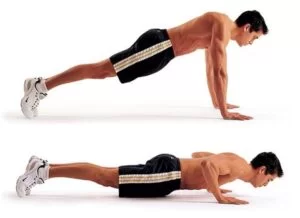
- Position yourself on your hands and knees, hands should be beneath your shoulders, and knees should be under your hips.
- Take step your feet backward and straighten your legs so that you are balanced on your palms and toes.
- Examine your body and hand position: Your body should create a straight line from head to hips to heels, and your hands should be directly under your shoulders or a little wider distance.
- Bend your elbows at a forty-five-degree angle to your body and decrease your body to the ground.
- Ensure to maintain your body in one straight line from the neck through the spine to the hips and downward to the heels.
- Push into your palms and push the floor surface away from you to come back up to a high plank, still maintaining your body in one straight line.
To increase the intensity of this exercise, you can perform variations such as incline push-ups (placing your hands on an elevated surface), decline push-ups (placing your feet on an elevated surface), or diamond push-ups (placing your hands close together in a diamond shape).
Incline push up
The incline push-up is an exercise that targets the upper portion of the pectoralis major muscle, as well as the triceps and anterior deltoids. It is a variation of the traditional push-up that involves elevating your hands on a bench, step, or other elevated surface.
To perform an incline push-up for pectoralis muscle exercise, follow these steps:
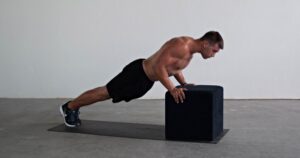
- Begin with a surface that is at a 15- to 30-degree angle.
- Put your hands at the same level as your shoulders.
- Decrease your body with bent elbows until your chest comes closer to the bench.
- Push up and straighten your arms until you come back to the initiate position.
- Do again this exercise for the desired number of repetitions.
To increase the intensity of this exercise, you can adjust the height of the elevated surface or perform variations such as using dumbbells instead of a bench or incorporating pauses or tempo changes into your repetitions.
Bench Press
The bench press is a compound exercise that targets the pectoralis major muscle, as well as other muscles such as the triceps, shoulders, and upper back. It is typically performed using a barbell or dumbbell and a weight bench.
To perform a bench press for pectoralis muscle exercise, follow these steps:
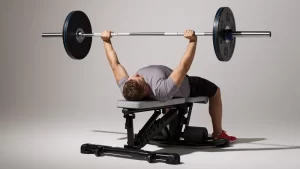
- Start with lying flat on your back on a weight bench and your feet should be flat on the ground.
- Put your hands a little wider than your shoulders and the barbell on a rack over your shoulders.
- Take the bar with an overhand grip (your palms should be facing out).
- Raise the barbell off the rack and bend your elbows to decrease it downward with control until it softly taps your chest.
- Push your feet into the ground and press the barbell back up until your arms are extended straight.
- Pause at the top and do it again.
To increase the intensity of this exercise, you can perform variations such as incline bench press (using an inclined bench to target the upper chest), decline bench press (using a declined bench to target the lower chest), or dumbbell flyes (lying on a flat bench and lowering dumbbells out to the sides).
Decline bench press
The decline bench press is an exercise that primarily targets the lower portion of the pectoralis major muscle, but also engages other muscles such as the triceps and anterior deltoids. It is typically performed using a flat or adjustable bench that is set at a decline angle of around 15 to 30 degrees.
To perform a decline bench press for pectoralis muscle exercise, follow these steps:
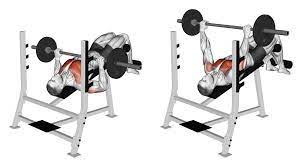
- Adjust the bench to a decline angle so that your head is lower than your hips.
- Start with lying down on the bench and position your head under the barbell.
- Grasp the barbell with your palms facing forward a little more than shoulder-width distance.
- Raise the bar off the rack and gradually decrease it to a position just under the nips.
- Gradually lift the bar to the initiate position.
- Do again this exercise for the desired number of repetitions.
To increase the intensity of this exercise, you can use heavier weights, perform more repetitions, or adjust the angle of the bench to target different areas of the chest. You can also perform variations such as using dumbbells instead of a barbell or incorporating pauses or tempo changes into your repetitions.
Incline bench press
The incline bench press is a popular exercise that targets the upper portion of the pectoralis major muscle, as well as the anterior deltoids and triceps. It involves lying on an inclined bench with your feet firmly on the ground and lifting a barbell or dumbbell from your chest to an extended position above your head.
To perform an incline bench press for pectoralis muscle exercise, follow these steps:
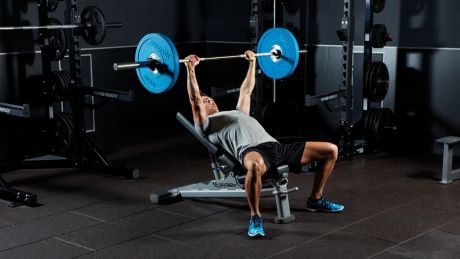
- The patient is lying on the back of the incline bench with their knees bent and feet flat on the floor.
- The patient takes the barbell, with the thumb which is placed around the barbell, and palms facing toward the feet.
- Push the arms straight in the direction of the ceiling to raise the weight off the rack.
- Position the weight above the collarbone.
- After that gradually decrease the weight down towards the chest, nearly in line with the mid-chest to just over the nipples.
- After that Pause for a moment after that press the weight back into the initiate position.
- Do the 8–12 repetitions for the full 3 sets.
To increase the intensity of this exercise, you can increase the weight of the barbell or dumbbells, adjust the angle of the bench, or perform variations such as using a close grip or a wide grip on the barbell.
Dumbbell Fly
The dumbbell fly is an isolation exercise that specifically targets the pectoralis major muscle. It is typically performed using dumbbells and a flat bench.
To perform a dumbbell fly for pectoralis muscle exercise, follow these steps:
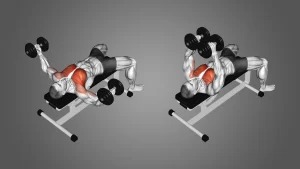
- Start with lying down on a bench (or the ground) and take a dumbbell in each hand directly over your chest.
- With a little bend in your elbows, twist your shoulders so your elbows should point out to the sides and your palms face each other. This is the initiate position.
- Decrease the dumbbells to the sides of your chest in a curved motion until you experience a mild stretch (not pull or ache) in your chest.
- Do exhalation as you do back the motion and use your chest muscles to press the dumbbells back to begin.
- Do again this exercise for the desired number of repetitions.
To increase the intensity of this exercise, you can use heavier dumbbells, perform more repetitions, or add a pause at the bottom of the movement to increase time under tension. You can also perform variations such as incline dumbbell flies (using an inclined bench to target the upper chest) or decline dumbbell flies (using a declined bench to target the lower chest).
Dumbbell Pullover
The dumbbell pullover is an exercise that primarily targets the pectoralis major muscle, but also engages other muscles such as the latissimus dorsi, triceps, and serratus anterior. It is typically performed using a dumbbell and a flat bench.
To perform a dumbbell pullover for pectoralis muscle exercise, follow these steps:
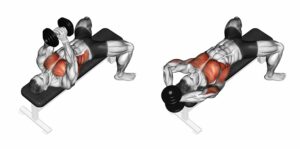
- Start with lying on the bench with your knees should be bent, and feet should be flat on the ground. Grasp a dumbbell at both ends, palms should be facing in, arms must be extended in the direction of the ceiling.
- Maintain your core engaged and your arms straight, and gradually take the weight back in the direction of the ground behind your head.
- Increase the weight as far as you can without experiencing your core coming off the floor.
- Gradually take the weight back to the initiate position. That is 1 repitation.
- Do again this exercise for the desired number of repetitions.
To increase the intensity of this exercise, you can use a heavier dumbbell, perform more repetitions, or add a pause at the bottom of the movement to increase time under tension. You can also perform variations such as using an incline bench to target the upper chest or using a decline bench to target the lower chest.
Cable crossover
The cable crossover is an exercise that primarily targets the pectoralis major muscle, but also engages other muscles such as the triceps and anterior deltoids. It is typically performed using a cable machine with two adjustable pulleys.
To perform a cable crossover for pectoralis muscle exercise, follow these steps:
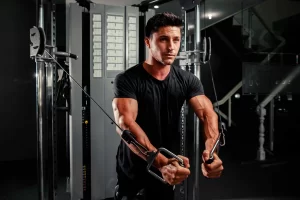
- Put the pulleys in a higher position and choose a mid-range of weight.
- Grasp a handle of pully in each hand.
- Take a step forward and plant your foot softly on the floor.
- DO the leaning of your torso in the forward direction and engage your core.
- Do the extension of your hands in a wide curve and breathe in.
- Take your hands in the direction of the midline of your body for one complete repetition.
- Do again this exercise for the desired number of repetitions.
To increase the intensity of this exercise, you can use heavier weights, perform more repetitions, or adjust the height of the pulleys to target different areas of the chest. You can also perform variations such as using a single pulley or performing a decline cable crossover to target the lower chest.
Pectoral Dumbbell Pull-on Swiss Ball
The Pectoral Dumbbell Pull-on Swiss Ball is an exercise that targets the pectoralis major muscles, as well as the anterior deltoids and triceps. It involves using a Swiss ball as a stabilizing surface while performing a dumbbell chest fly motion.
To perform the Pectoral Dumbbell Pull-on Swiss Ball exercise, follow these steps:
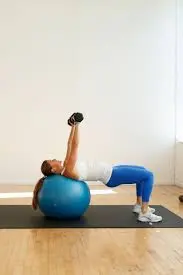
- Pick a set of dumbbells that is suitable for your level of fitness.
- Lie on a Swiss ball with your feet firmly planted on the ground and your back straight.
- Hold the dumbbells in each hand with your palms facing each other and your arms extended out to the sides.
- Slowly lower the dumbbells towards the ground, keeping your elbows slightly bent.
- Pause briefly at the bottom of the movement, then use your chest muscles to pull the dumbbells back up to the starting position.
- do again this exercise for the desired number of repetitions.
To increase the intensity of this exercise, you can increase the weight of the dumbbells, adjust your body position on the Swiss ball, or perform variations such as alternating one arm at a time or adding a pause at the top of the movement.
Chest dip
The Chest Dip is an exercise that targets the pectoralis major muscles, as well as the triceps and anterior deltoids. It involves using parallel bars as a stabilizing surface while performing a dipping motion.
To perform the Chest Dip exercise, follow these steps:
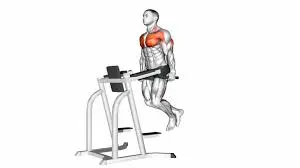
- The patient should be in the standing position which is facing the two parallel bars and grasp them, palms should be facing inward.
- Then Straighten the elbow joint and press into the hands, lifting the body so that it is in line with the hands.
- Then, bend the elbow joint and lower the chest toward the hands.
- Pause, then press back into the initiate position.
- Do again this exercise for 8–12 repetitions for at least the 3 sets.
To increase the intensity of this exercise, you can add weight by using a weight belt or holding a dumbbell between your feet, adjusting the width of the parallel bars, or performing variations such as leaning forward more or adding a pause at the bottom of the movement.
Scapular Retraction/Protraction movement
Scapular retraction/protraction movement is an exercise that targets the pectoralis major muscle, which is the large muscle that covers the front of the chest. This exercise involves moving the shoulder blades (scapulae) back and forth while maintaining a stable position in the upper body.
To perform scapular retraction/protraction movement, follow these steps:
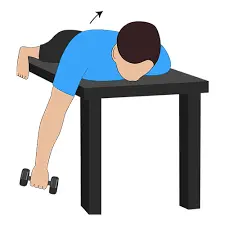
- Start with lying on the stomach means in a prone position on a table or bed with the injured arm hanging by the side.
- It is necessary to maintain the elbow joint straight and raise the weight gradually.
- Try to squeeze the shoulder blade in the opposite direction side as you can possible.
- Then get back to the starting position gradually and do again this exercise.
- Perform this exercise for 2–3 times per day.
To increase the intensity of this exercise, you can use resistance bands or weights, adjust the angle of your arms, or perform variations such as alternating between retraction and protraction movements. It is important to note that this exercise may not be suitable for individuals with shoulder or neck injuries, and proper warm-up and stretching should be done before attempting this exercise.
Bent-Over Horizontal Abduction
Bent-over horizontal abduction is an exercise that targets the pectoralis major muscle, specifically, the fibers that run horizontally across the chest. This exercise involves moving the arms away from the body while in a bent-over position.
To perform bent-over horizontal abduction, follow these steps:

- Start with lying on the stomach means in a prone position on a table or bed with the injured arm hanging over the side.
- It is important to maintain your arm straight and gradually lift it to eye level.
- After that gradually decrease it back to the initiate position and do again this exercise.
- Perform this exercise for 2–3 times per day.
- Do the exercise by pressing on the side of your head. do it again 8 times, then switch sides.
To increase the intensity of this exercise, you can use heavier dumbbells or resistance bands, adjust the angle of your arms, or perform variations such as alternating between horizontal abduction and adduction movements. It is important to note that this exercise may not be suitable for individuals with shoulder or neck injuries, and proper warm-up and stretching should be done before attempting this exercise.
Prone Rows Exercise
The prone row exercise is a compound exercise that targets multiple muscles in the upper body, including the pectoralis major muscle. This exercise involves lying face down on a bench or other flat surface and pulling weights toward your chest.
To perform prone rows, follow these steps:
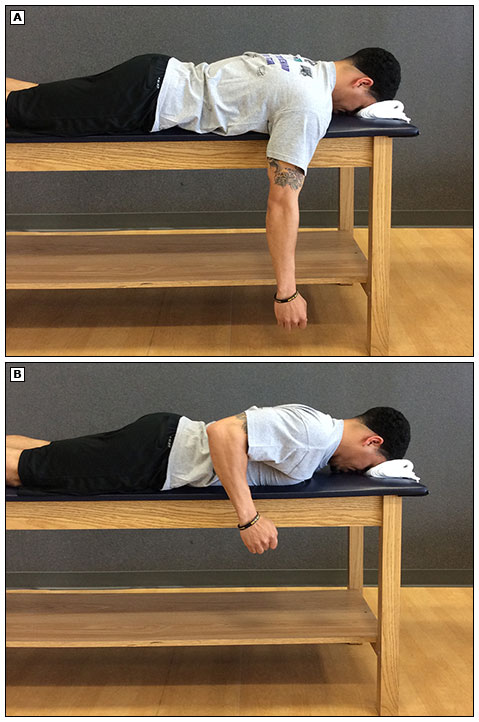
- Lie on your stomach with the arms dangling off the side of the bed (try angling the body so the head is facing the corner of the bed).
- Use a pillow beneath the stomach for comfort. Begin by pulling arms backward while bending elbows & and squeezing shoulder blades together then slowly return to the starting position.
- Do not raise the head upward while pulling the arms backward.
- Repeat 20 times. Perform 2 times a day.
To increase the intensity of this exercise, you can use heavier dumbbells or resistance bands, adjust the angle of the bench, or perform variations such as alternating between single-arm and double-arm rows. It is important to note that this exercise may not be suitable for individuals with lower back or shoulder injuries, and proper warm-up and stretching should be done before attempting this exercise.
Stretching of pectoralis muscle
Gross Stretch
The Gross Stretch for pectoralis is a stretching exercise that targets the pectoral muscles, which are located in the chest area.
To perform the Gross Stretch for the pectoralis, follow these steps:
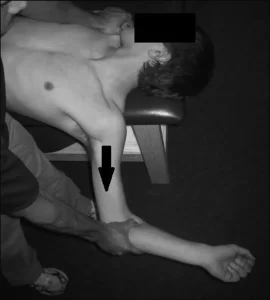
- Start with lying on a table at the back. Allow one arm to hang off the side with the shoulder placed at the edge.
- Bend the elbow at ninety degrees so that the hand is facing the direction of the therapist’s head.
- Now a therapist gently presses on the forearm of the hanging arm until they feel slight pressure at the front of the chest & and shoulder.
- Maintain for 30 seconds, and then do it again on the other side.
- Repeat 3 repetitions at a time.
Doorway Pectoral Stretch
The Doorway Pectoral Stretch is a simple stretching exercise that targets the pectoral muscles, which are located in the chest area. This stretch can be done anywhere you have access to a doorway.
To perform the Doorway Pectoral Stretch, follow these steps:
- Begin with standing near a door frame or corner of a wall.
- maintain your back straight and your inner core engaged, and take your arm up against the wall with the elbow and shoulder bent at ninety degrees.
- With the arm placed on the wall, take out your opposite shoulder back followed by your torso in a straight line. Maintain the back straight and the core engaged.
- Maintain this for 30 seconds and do it again 3 times on each side 2 times per day.
Camel Pose Stretch
Camel Pose Stretch, also known as Ustrasana, is a yoga pose that targets the pectoralis muscles, as well as the hip flexors and quadriceps. Here’s how to perform the Camel Pose Stretch:
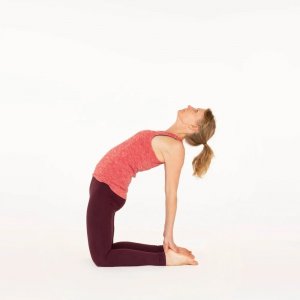
- Begin with kneeling on the ground with your knees hip-width distance and your hands on your waist. Tuck your toes or put them flat against the floor.
- Gradually reach to the back and put one hand on each heel.
- Maintain your chest raised, shoulders back and down, engage your core, and gradually push your hips forward.
- Maintain for 15-20 seconds and do it again 3 times.
- To release the pose, bring your hands back to your lower back and slowly come back to a kneeling position.
Hand Behind the Back Stretch
The Hand Behind the Back Stretch is another yoga pose that targets the pectoralis muscles. Here’s how to perform the stretch:

- Start with standing tall with your feet shoulder-width distance. grasp your fingers behind your back and straighten your arms.
- Maintain your chest raised and pull your shoulder blades downward.
- Maintain for 15-20 seconds and do it again 3 times.
- To release the pose, slowly release your hands and bring your arms back to your sides.
Floor Angels Stretch
The Floor Angels Stretch is a yoga pose that targets the pectoralis muscles. Here’s how to perform the stretch:
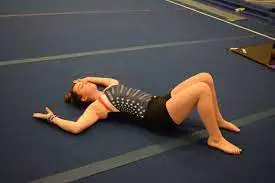
- Begin in a supine position with feet hip-width distance and flat on the ground.
- placed both arms to the side at a ninety-degree angle with palms facing upwards toward the ceiling.
- maintain contact with the ground at all times, and gradually take your arms up over your head until they are fully extended.
- Then gradually take both arms back to the ninety-degree initiate position.
- Do again this movement 10 times for 3 sets.
- Remember to maintain your back flat against the ground and ribs tucked at all times
Above-the-head Chest Stretch
The Above-the-head Chest Stretch is a simple yoga pose that targets the pectoralis muscles. Here’s how to perform the stretch:
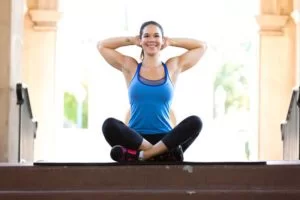
- Start with a sitting or standing position, interlock the fingers, then bend the elbow joint and lift the arms over the head.
- Then softly squeeze the shoulder joint blades together and move the elbow joint and hands backward.
- Vary the height of the hands to emphasize the shoulder joint and chest means hands are behind the head, hands are on top of the head, and the hand is also a few inches above the head.
- Hold the stretch for 10-15 seconds, breathing deeply and slowly.
- To release the stretch, inhale and slowly raise your arms back up towards the ceiling, keeping them straight and in line with your shoulders.
Bent-arm Wall Stretch
The Bent-arm Wall Stretch is a yoga pose that targets the pectoralis muscles. Here’s how to perform the stretch:

- Begin with assuming a split stance, The Right leg is in the front and the left leg is in the back, in a doorway, and at the end of a wall.
- Then take the left arm up to shoulder level and place the palm and inside of the arm on the wall surface or doorway.
- After that arm looks like a goalpost.
- Then softly press the chest through the open space to experience the stretch.
- Moving the arm higher and lower which is allow to you stretch the various sections of the chest.
- To release the stretch, step back and bring your arms down to your sides.
- Then do again this exercise on the other side.
Extended Child’s Pose on Fingertips Stretch
The Extended Child’s Pose on Fingertips Stretch is a yoga pose that targets the pectoralis muscles. Here’s how to perform the stretch:
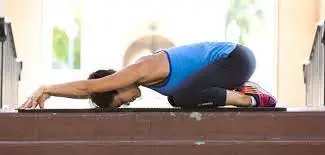
- Begin with Kneeling on the ground.
- Try to Touch the big toes together and then sit on the heels.
- After that separate the knee joint about as wide as the hip joint.
- Then Bend them forward from the hip joint and walk the hands out as far in front of them as possible.
- Maintain the arms in extension and palms facing down then come up onto the fingertips as if the ball is beneath the palms.
- Melts the chest toward the ground.
- Hold the stretch for 10-15 seconds, breathing deeply and slowly.
- To release the stretch, gently walk your hands back toward your knees and come back up to a tabletop position.
Side-Lying Parallel Arm Chest Stretch
The Side-Lying Parallel Arm Chest Stretch is a yoga pose that targets the pectoralis muscles. Here’s how to perform the stretch:
- Start with lying prone on the stomach then bring both arms out to the sides then palms facing down and create the letter, T.
- After that begin to roll onto the right side by pushing with the other hand.
- Raise the left leg, bend the knee joint, and place the left foot behind you on the floor for stability.
- Must be Keep the left hand on the ground in order to maintain balance.
- For the experience of the extra stretch, raise the left hand in the direction of the ceiling.
- Hold the stretch for 10-15 seconds, breathing deeply and slowly.
- To release the stretch, gently rotate your torso back to the starting position.
- Then do again this stretching on the other side.
What is the need for pectoralis muscle-strengthening?
There are so many benefits to having strong pectoral muscles. It is very necessary to strengthen the pectoral muscles on a daily basis as these muscles have an impact on several body functions and motions during training and in daily life:
- Strong pectoral muscles can help in improving your posture. Good posture is very important to help us function optimally in daily life as well as while performing physical exercises. The correct form while exercising is necessary. Proper posture act as a crucial role in getting your form right.
- A strong chest improves the strength of your back muscles. Together, these muscles maintain you upright and ensure good posture. Tight chest muscles can result in your shoulders slouching. This means it is essential to strengthen the chest muscles and to stretch them as well.
- Strong pectoral muscles contribute to overall upper-body strength. This is because the pectoral muscles are included in many various upper-body motions
- Strong chest muscles help in improving your ability to push things.
- Your chest muscles play a crucial role in your ability to push a heavy object.
- Simple motions like pushing yourself off the floor also impact pectoral strength – a simple push-up can be quite challenging if you have no pectoral strength.
- Strong pectoral muscles also help in improving your ability to do swinging motions. If you have weak pectoral strength, playing a round of golf or a tennis match would not be just as easy.
- Other than the physical benefits of pectoral strength, the aesthetic benefits are also great especially if you are a bodybuilding athlete or competitor. Strong pectoral muscles represent that you can raise heavier and train harder.
FAQs
What muscle makes your chest bigger?
Pectoralis Major
The pectoralis major forms a major part of your chest muscle mass. It is large and fan-shaped and is made up of a sternocostal head and a clavicular head.
Pectoralis Minor
The pectoralis minor muscle is located just under the pectoralis major. Its job is to help in pulling the shoulder forward and down.
How Many Chest Exercises Should You Perform Per Workout?
You should do 1-4 chest exercises per workout, with the maximum range being 2-3 various chest exercises in a single training session. reason for that is most lifters, performing any more than 3-4 different movements can result in decreased returns, excessive “trash” volume, and suboptimal quality volume.
What are some exercises that target the pectoralis muscle?
Some exercises that target the pectoralis muscle include push-ups, bench presses, dumbbell flies, cable crossovers, and chest dips.
How often should I work out my pectoralis muscles?
It is recommended to train your pectoralis muscles 1-2 times per week, with at least 48 hours of rest between workouts.
Can I do pectoralis exercises at home without equipment?
Yes, there are many bodyweight exercises that can target the pectoralis muscles such as push-ups, wide-grip push-ups, and decline push-ups.
Should I stretch my pectoralis muscles before or after exercise?
It is recommended to stretch your pectoralis muscles after exercise when they are warm and pliable. Stretching before exercise can raise the chances of risk of injury.
Can women do pectoralis exercises?
Yes, women can do pectoralis exercises. Building chest muscles can improve posture and overall upper body strength.
References
- J. (2022, July 16). Pectoralis Minor Muscle – Origin, Insertion, Function, Exercise. Samarpan Physiotherapy Clinic. https://samarpanphysioclinic.com/pectoralis-minor-muscle-function-exercise/#Stretching_Exercise_of_Pectoralis_Minor_Muscle
- Bach, E. (2023, September 20). Pectoral Exercises: How to Build a Strong and Defined Chest. LIVESTRONG.COM. https://www.livestrong.com/article/459314-top-5-pectoral-workouts/
- Nash, S. L. (2022, January 27). The 5 Best Lower Chest Exercises for Defined AF Pecs. Greatist. https://greatist.com/fitness/lower-chest-exercises
- B., & B. (2022, August 17). Why Pectoral Strength is Necessary. https://trifocusfitnessacademy.co.za/personal-fitness-training-blog/why-pectoral-strength-is-necessary/#:~:text=Strong%20pectoral%20muscles%20contribute%20to,to%20push%20a%20heavy%20object.
- Image: Figure 2. Gross stretch procedure. Arrow indicates an overpressure. . . (n.d.). ResearchGate. https://www.researchgate.net/figure/Gross-stretch-procedure-Arrow-indicates-an-overpressure-force-applied-by-the-clinician_fig2_235729413
- Image: Before you continue. (n.d.). https://www.google.com/imgres?imgurl=https%3A%2F%2Fpost.medicalnewstoday.com
- Image: 5 Chest Stretch Variations. (2015, September 17). https://www.acefitness.org/resources/everyone/blog/5657/5-chest-stretch-variations/
- Image: Thompson, T. (2023, January 26). 18 Exercises for Shoulder Rehabilitation (Free PDF Download). Patient Exercises. https://www.patientexercises.com/18-exercises-for-shoulder-rehabilitation-free-pdf-download/
- Image: Cpt, L. B. (2022, February 21). 3 Best Chest Exercises Using An Exercise Ball! Nourish, Move, Love. https://www.nourishmovelove.com/web-stories/best-chest-exercises-using-an-exercise-ball/
- Image: Stefanov, P. (2022, February 11). Chest Dip – How to Instructions, Proper Exercise Form and Tips. Hevy – #1 Workout Tracker & Planner Gym Log App. https://www.hevyapp.com/exercises/how-to-chest-dip/
- Image: Warner, J. (2022, March 11). Use the low cable crossover to build a big and strong chest. New Body Plan. https://www.newbodyplan.co.uk/training/chest/sculp-strong-defined-chest-low-cable-crossovers/

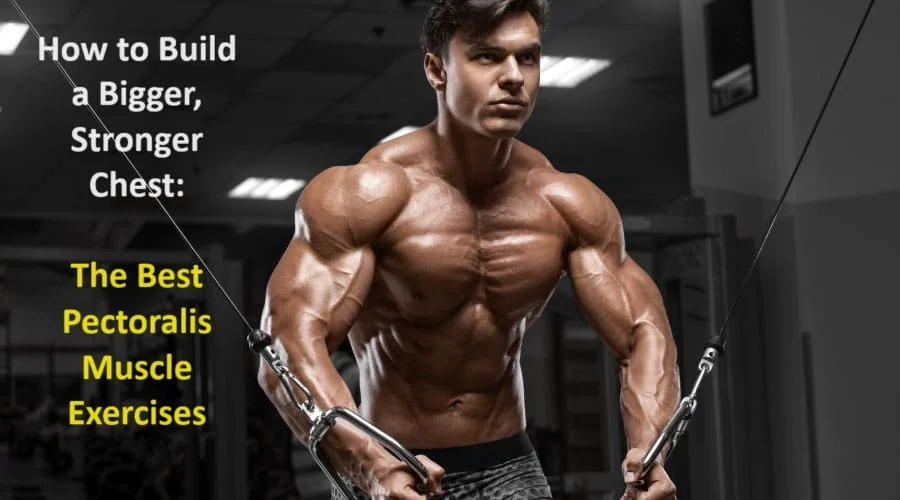
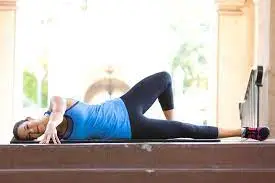
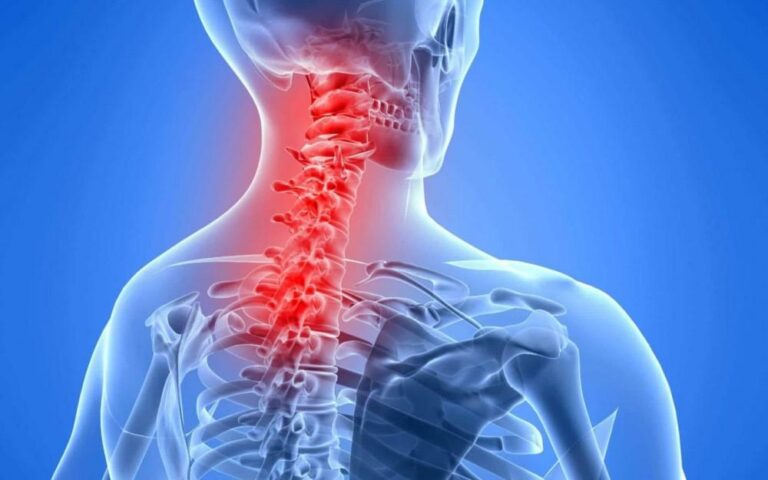
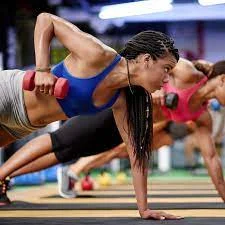

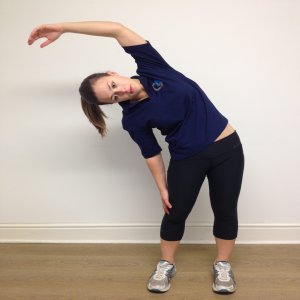
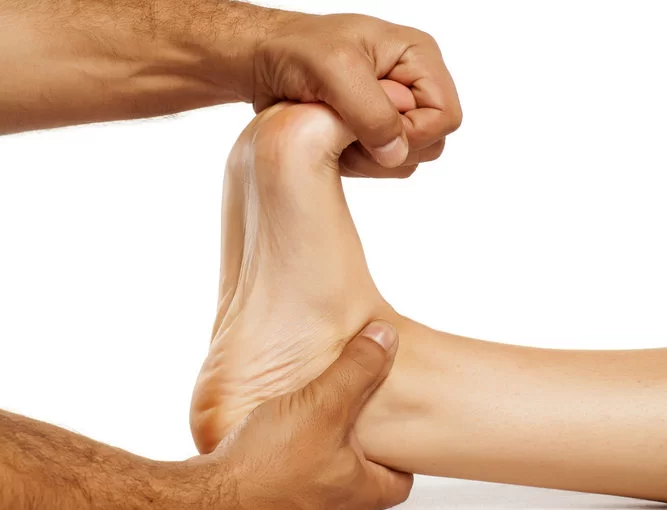

One Comment